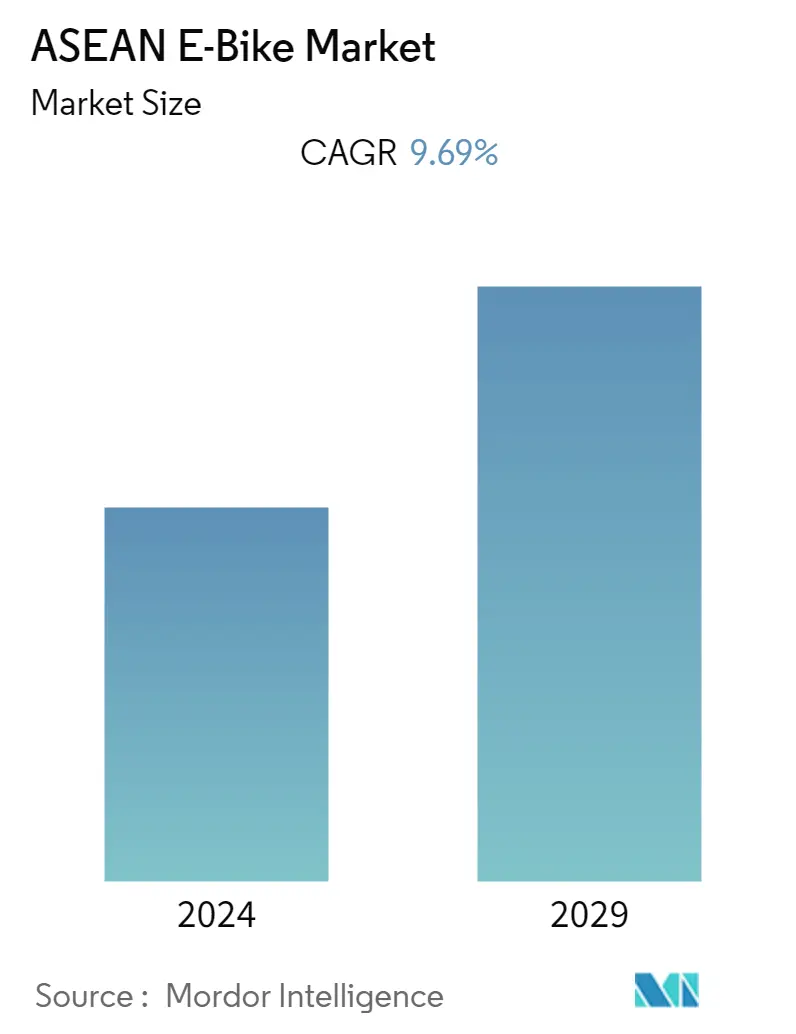Market Size of ASEAN E-Bike Industry

| Study Period | 2019 - 2029 |
| Base Year For Estimation | 2023 |
| Forecast Data Period | 2024 - 2029 |
| Historical Data Period | 2019 - 2022 |
| CAGR | 9.69 % |
| Market Concentration | Low |
Major Players.webp)
*Disclaimer: Major Players sorted in no particular order |
ASEAN E-Bike Market Analysis
The ASEAN e-bike market is valued at USD 51.79 million in 2021 and is expected to reach USD 85.15 million in value by 2027 at a CAGR of 9.69% during the forecast period.
The electric bike (e-bike) market was positively impacted by COVID-19 because commuters mostly avoided public transportation. E-bikes are being used as a safer, less expensive, and more convenient alternative to public transportation. Due to social-distancing guidelines and government restrictions on public transportation, bicycles became the preferred mode of daily transportation. Despite the easing of restrictions in the post-pandemic period, sales were sluggish during the initial pandemic phase.
Over the long-term, one of the main factors driving the expansion of the electric bike (e-bike) market is the rise in government initiatives to promote the use of electric bikes. These bicycles are regarded as an eco-friendly and effective commute option. The expansion of the market is sped up by the rising preference of consumers for electric or e-bikes. Due to their smaller size, health benefits, and higher speed with less effort, these bikes are widely used. The market is further influenced by the region's growing tourism industry.Electric bikes are in high demand as a result of the rising number of tourists and their impact on traffic.
Additionally, the e-bike market in ASEAN region is also positively impacted by an increase in disposable income, expansion of the e-bike manufacturers in South-East Asia are the growing demand for eco-friendly modes of transportation, government initiatives to reduce emissions, and the growing traffic congestion in major cities.
ASEAN E-Bike Industry Segmentation
The ASEAN e-bike market report covers a detailed study of the latest trends and innovations. The scope of the report covers segmentation based on Propulsion Type, Application Type, Battery Type, Power Type and Country.
By Propulsion type, the market is segmented into Pedal-Assisted and Throttle-Assisted (Power-on-Demand).
By Application, the market is segmented into City/Urban, Trekking (E-Mountain Bikes/E-MTB), And Cargo.
By Battery Type, the market is segmented into Lithium-Ion and Lead-Acid Batteries.
and by Country, the market is segmented into Vietnam, Indonesia, Malaysia, Thailand, Singapore, and the Rest of South-East Asia.
The report also provides market sizing and forecast for all the above-mentioned segments.
| Propulsion Type | |
| Pedal-assisted | |
| Throttle-assisted (Power-on-demand) |
| Application | |
| City/Urban | |
| Trekking (E-mountain Bikes/E-MTB) | |
| Cargo |
| Battery Type | |
| Lithium-ion | |
| Lead-acid |
| Country | |
| Vietnam | |
| Indonesia | |
| Malaysia | |
| Thailand | |
| Singapore | |
| Rest of South-East Asia |
ASEAN E-Bike Market Size Summary
The ASEAN e-bike market is experiencing significant growth, driven by a combination of factors including increased government initiatives, rising consumer preference for eco-friendly transportation, and the region's expanding tourism industry. The market has benefited from the COVID-19 pandemic as commuters sought alternatives to public transportation, leading to a surge in e-bike adoption. The region's diverse manufacturing hubs, such as Malaysia, Vietnam, and Thailand, are contributing to the market's expansion by providing a base for e-bike production and attracting foreign investments. The ASEAN Economic Community's efforts towards regional economic integration and the establishment of a common market have further bolstered the market's growth prospects.
In Thailand, the government is actively promoting e-bike usage through incentives and infrastructure development, aiming to reduce pollution and traffic congestion. The market is characterized by a high level of consolidation, with major players like Giant Bicycles, Merida, and Yamaha dominating the landscape. These companies are continuously innovating and expanding their product portfolios to meet the growing demand. The e-bike market in ASEAN is poised for continued expansion, supported by increasing disposable incomes, the rise of shared mobility services, and the region's strategic position as a manufacturing hub for electric vehicles.
ASEAN E-Bike Market Size - Table of Contents
-
1. MARKET DYNAMICS
-
1.1 Market Drivers
-
1.2 Market Restraints
-
1.3 Porters 5 Force Analysis
-
1.3.1 Threat of New Entrants
-
1.3.2 Bargaining Power of Buyers/Consumers
-
1.3.3 Bargaining Power of Suppliers
-
1.3.4 Threat of Substitute Products
-
1.3.5 Intensity of Competitive Rivalry
-
-
-
2. MARKET SEGMENTATION
-
2.1 Propulsion Type
-
2.1.1 Pedal-assisted
-
2.1.2 Throttle-assisted (Power-on-demand)
-
-
2.2 Application
-
2.2.1 City/Urban
-
2.2.2 Trekking (E-mountain Bikes/E-MTB)
-
2.2.3 Cargo
-
-
2.3 Battery Type
-
2.3.1 Lithium-ion
-
2.3.2 Lead-acid
-
-
2.4 Country
-
2.4.1 Vietnam
-
2.4.2 Indonesia
-
2.4.3 Malaysia
-
2.4.4 Thailand
-
2.4.5 Singapore
-
2.4.6 Rest of South-East Asia
-
-
ASEAN E-Bike Market Size FAQs
What is the current ASEAN E-Bike Market size?
The ASEAN E-Bike Market is projected to register a CAGR of 9.69% during the forecast period (2024-2029)
Who are the key players in ASEAN E-Bike Market?
Giant Manufacturing Co Ltd, Merida Industry Co Ltd, Yamaha Motor Co Ltd, Accell Group N.V and Trek Bicycle Corporation are the major companies operating in the ASEAN E-Bike Market.

